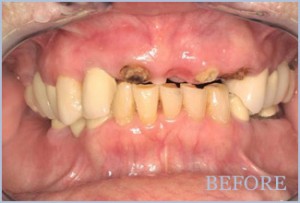Header logo
header top contact widget
Learn More Blog
Dental Fear Can Lead To Gum Disease, Tooth Loss
Posted on Nov 23, 2021 by William J. Claiborne, DDS MS
Fear is a natural reaction to things that may harm us; it’s a safety mechanism activated by the brain. Take snakes, for instance. Even harmless snakes tend to provoke an initial reaction that warns of impending danger.
Some fears are learned, however. Some people are afraid of dogs, usually stemming from a frightful encounter as children. The incident triggers something in the brain that reminds the individual, even into adulthood, that dogs are to be feared.
When it comes to the fear of dentistry, it often exists because of a traumatic incident in the patient’s past. Or, in some cases, it exists for unknown reasons. Too, certain smells, sounds or sights can trigger the “panicky” reaction some people have to dental visits.
As a periodontist in Asheville, I have a firsthand view of just what dental fear can do to oral health. Avoiding regular dental care is a sure recipe for cavities, periodontal (gum) disease, and eventual tooth loss.
Typically, adults who avoid dental visits feel they are doing an adequate job maintaining their oral wellness at home. In some minds, “I brush twice a day,” can be the justification to bypass recommended 6-month dental check-ups and cleanings.
Yet, even the best of at-home dental hygiene can be insufficient to the buildup of tartar.
Tartar is the hardened form of plaque, which is a sticky film of bacteria that accumulates in the mouth. In the form of tartar, this cement-hard mass of bacteria cannot be brushed or flossed away. It can only be removed by a dentist or hygienist using special tools.
While plaque can cause bad breath and a “furry” feeling mouth, tartar eats away at tender gum tissues and bores into tooth enamel. As it grows, it works its way below the gum line, creating inflammation in the gum tissues.
Early symptoms of gum disease, known as gingivitis, are tender or swollen gums. You may see blood in the sink when brushing teeth. Breath odor may be bad on a regular basis.
At this point, proper measures may be able to reverse the progression of these rapidly-reproducing bacteria. This requires thorough brushing (twice a day, at the very least), daily flossing, drinking lots of plain water, and using an oral rinse to control bacteria levels.
However, if tartar exists, it’s not going to go away. It will continue to amass and attack the gums and work its way into the tissues below. When the bacteria reach an uncontrollable level, they become infectious.
Think of gum disease bacteria as you would water in a pan on the stove. The heat will eventually cause bubbles to form on the bottom of the pan. This can be likened to gingivitis.
However, as the water heats more, bubbles start to move to the surface. This can symbolize the development of gum disease. The symptoms of gum disease include gums that turn red and bleed easily and persistent bad breath.
When advanced stage periodontal disease develops (periodontitis), imagine the water at full boil. Unfortunately, once aboil, the roil continues even after you remove the pan from the heat. This is known as systemic inflammation.

Gum disease is the nation’s leading cause of adult tooth loss. Yet, the bacteria that destroy gums and the structures that support natural teeth don’t remain confined to the mouth. Through tears in diseased gum tissues, these infectious bacteria can enter the bloodstream.
Research has correlated oral bacteria to a long list of serious health problems. Some can be activated by the bacteria of periodontitis, some are worsened. These include heart disease, stroke, Alzheimer’s disease, arthritis, diabetes, preterm babies, erectile dysfunction (ED), some cancers (including pancreatic), and more.
Obviously, these bacteria are potent and a threat to overall health. For those who avoid dental care due to anxiety or fear, knowing all this is not necessarily going to change their resistance. We understand that it’s still difficult to overcome the challenges even knowing there are risks.
There are options, however, for even high fear dental patients.
In our office, we offer I.V. sedation (“twilight sleep”) as well as oral sedation. Oral sedation is in pill form and creates a totally relaxed feeling. It enables patients to recover quickly and offers an amnesiac effect.
I.V. sedation is a deeper level of sedative. This places patients in a sleep state and erases most or all memory of the procedure after. With both sedations, however, we apply numbing medications to the area being treated to create optimal comfort for patients. We want patients to be in total comfort throughout their treatment, regardless of the addition of sedation.
We also have a reputation for treating our patients with respect and a gentle touch. We are just as committed to comfort for patients who do not want to be sedated as we are for those who are. Our goal is to help each person achieve a healthy, confident smile.
One of the most satisfying parts of my specialty is helping a once-fearful patient achieve a healthy, confident smile and see dental care as a welcomed part of their health care commitment.
If you are ready to get past your dental fears so you can have the smile you desire, begin by calling our Asheville periodontal office at: 828-274-9440 and speaking with our friendly staff. You can begin with a consultation, if desired.
Recent Posts
Categories
Archives
- September 2024
- August 2024
- July 2024
- June 2024
- May 2024
- April 2024
- March 2024
- February 2024
- January 2024
- December 2023
- November 2023
- October 2023
- September 2023
- August 2023
- July 2023
- June 2023
- May 2023
- April 2023
- March 2023
- February 2023
- January 2023
- December 2022
- November 2022
- October 2022
- September 2022
- August 2022
- July 2022
- June 2022
- May 2022
- April 2022
- March 2022
- February 2022
- January 2022
- December 2021
- November 2021
- October 2021
- September 2021
- August 2021
- July 2021
- June 2021
- May 2021
- April 2021
- March 2021
- February 2021
- January 2021
- December 2020
- November 2020
- October 2020
- September 2020
- August 2020
- July 2020
- June 2020
- May 2020
- April 2020
- March 2020
- February 2020
- January 2020
- December 2019
- November 2019
- October 2019
- September 2019
- August 2019
- July 2019
- June 2019
- May 2019
- April 2019
- March 2019
- February 2019
- January 2019
- December 2018
- November 2018
- October 2018
- September 2018
- August 2018
- July 2018
- June 2018
- May 2018
- April 2018
- March 2018
- February 2018
- January 2018
- December 2017
- November 2017
- October 2017
- September 2017
- August 2017
- July 2017
- June 2017
- May 2017
- April 2017
- March 2017
- February 2017
- January 2017
- December 2016
- November 2016
- October 2016
- September 2016
- August 2016
- July 2016
- June 2016
- May 2016
- April 2016
- March 2016
- February 2016
- January 2016
- December 2015
- November 2015
- October 2015
- September 2015
- August 2015
- July 2015
- June 2015
- May 2015
- April 2015
- March 2015
- February 2015
- January 2015
- December 2014
- November 2014
- October 2014
- September 2014
- August 2014
- July 2014
- June 2014
- May 2014
- April 2014
- March 2014
- February 2014
- January 2014
- December 2013
- November 2013
- October 2013
- September 2013
- August 2013
- July 2013
- June 2013
- May 2013
- April 2013
- March 2013
- February 2013
- January 2013
- December 2012
- November 2012
- October 2012
- September 2012
- August 2012
- July 2012
- June 2012

